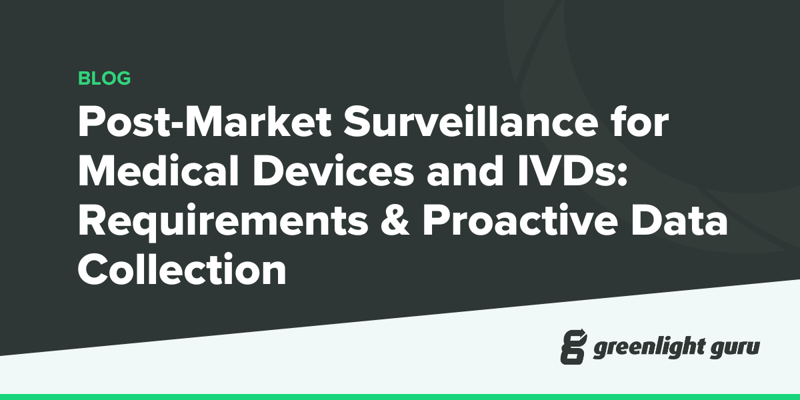Post-Market Surveillance for Medical Devices & IVDs: Requirements & Proactive Data Collection

The entry into force of Regulation (EU) 2017/745 on medical devices (MDR) and Regulation (EU) 2017/746 on in vitro diagnostic medical devices (IVDR) has introduced a series of regulatory requirements for post-market surveillance (PMS), which all manufacturers of medical devices (MD) and in vitro diagnostic devices (IVD) must follow. The aim is to ensure a high level of safety and performance for devices placed on the European Union market.
PMS is a continuous and systematic process that enables manufacturers, in collaboration with other economic operators, to collect and analyze data on the quality, safety, and performance of their devices on the market throughout their lifecycle. This process is crucial for identifying any needs for immediate corrective or preventive actions.
Both regulations require the implementation of a PMS management system, proportionate to the risk class and suitable for the type of device, for the systematic collection and analysis of post-market data.
Article 83 of the MDR and Article 78 of the IVDR detail the role of PMS data, specifying that these must be used for the following purposes:
- Updating the risk-benefit assessment and improving risk management, as indicated in Annex I, Chapter I;
- Updating design and manufacturing information, instructions for use, and labeling;
- Updating the clinical evaluation of medical devices/performance evaluation of IVDs;
- Updating the summary of safety and clinical performance (or performance) according to Article 32 of the MDR and Article 29 of the IVDR;
- Identifying the need for preventive, corrective, and safety corrective actions;
- Identifying opportunities to improve the usability, performance, and safety of the device;
- Contributing to the PMS of other devices, where applicable; and
- Identifying and reporting trends according to Article 88 of the MDR and Article 83 of the IVDR.
The PMS system is based on a post-market surveillance plan (PMSP), which describes the activities to be carried out, implementation timelines, and evaluation criteria. This includes planning for post-market clinical follow-up (PMCF) with indications of procedures and methods for collecting performance data (Articles 84 (MDR) and 79 (IVDR)).
According to the established PMSP, manufacturers of Class I medical devices must prepare a post-market surveillance report (PMSR), which must include a summary of the data collected within the PMS framework, as well as an assessment of potential risks and corrective and preventive actions taken.
Manufacturers of Class IIa, IIb, and III medical devices are required to prepare a periodic safety update report (PSUR), updated at least once every two years for Class IIa devices and at least once a year for Class IIb and III devices. Specifically, the PSUR, as per Article 86 MDR, must indicate:
- Conclusions for use in the risk-benefit assessment;
- Main findings from the PMCF; and
- The sales volume of the device and an estimate of the size and other characteristics of the population using the device, and if possible, the frequency of use of the device.
For in vitro diagnostic devices, there are no significant differences: the PMSR is prepared for Class A and B devices according to Article 80 (IVDR), updated as necessary and made available to the competent authority upon request. The PSUR must be prepared for Class C and D devices and updated annually as required by Article 81 (IVDR).
EUDAMED Database
The data collected within the PMS framework must be entered into the European database EUDAMED according to Article 92 (MDR) and Article 87 (IVDR). EUDAMED is an electronic platform that allows competent authorities and other stakeholders to access and process data on the safety and performance of medical devices and in vitro diagnostic devices placed on the EU market.
It is important to note that the post-market surveillance module is still under development and will be released once EUDAMED is declared fully operational.
Sources of PMS Data
It is important to consider that post-market surveillance should not be understood merely as a passive collection of information related to the device on the market (e.g., collection of complaints, reports of serious and non-serious incidents, etc.), but rather as a combination of reactive activities and proactive and systematic collection, recording, and analysis of data on the quality, performance, and safety of a device throughout its entire lifecycle.
Specifically, among the proactive data collection methods indicated in the standard “ISO/TR 20416:2020 Medical devices - Post-market surveillance for manufacturers,” are:
- Written or electronic questionnaires
- User interviews
- Literature research
- Use of registries
- PMCF studies
- Information released by regulatory agencies
In this context, questionnaires are an effective tool as they allow for the collection of a wide range of clinical data from a large number of patients/users relatively easily, quickly, and at a lower cost compared to other methods (e.g., post-market clinical investigations).
Moreover, they have the advantage of being fully customizable based on the type of device and to meet the specific needs of the sponsor.
However, it is important to use questionnaires appropriately to ensure the quality and reliability of the data collected. For this purpose, the ISO/TR 20416:2020 standard provides guidelines, specifying in particular that questionnaires must be:
- Designed to be understandable and easy to complete,
- Validated to ensure accurate measurement of the desired aspects, and
- Distributed to a representative sample of the target population.
The Impact of PMS Data on the Clinical Evaluation of Medical Devices
The new regulations have also raised the level of regulatory requirements regarding the collection of clinical data and evidence. They place particular emphasis on the clinical evaluation/performance evaluation process to confirm compliance with general safety and performance requirements (GSPR), including the incorporation of post-market surveillance data into the clinical evaluation/performance evaluation process.
In particular, in the MDR, clinically relevant information resulting from post-market surveillance, especially post-market clinical follow-up, falls under the definition of "clinical data" provided by Article 2 and can thus be used to update any relevant part of the technical documentation, such as those related to risk assessment, determination of the benefit-risk ratio, and clinical evaluation.
Moreover, the MDCG 2020-6 guideline – 'Regulation (EU) 2017/745: Clinical evidence needed for medical devices previously CE marked under Directives 93/42/EEC or 90/385/EEC - A guide for manufacturers and notified bodies' provides a harmonized approach regarding clinical data that provide sufficient clinical evidence for demonstrating compliance with applicable GSPR for previously CE-marked medical devices (legacy devices) that need to be recertified under the MDR.
Specifically, the guideline stipulates that relevant clinical data from PMS, particularly those from PMCF, can be incorporated into the clinical evaluation process. The clinical evaluation plan must therefore include a strategy and methodology for systematically collecting, summarizing, and evaluating PMS data, which can be used to demonstrate the continuity of safety and performance and support the acceptability of the device's benefit-risk ratio.
Conclusion
The PMS requirements established by the MDR and IVDR represent a significant shift from previous regulations. The new requirements are more stringent and require manufacturers, in collaboration with other economic operators, to proactively collect and analyze a wide range of data on the safety and performance of their devices.
The objective of these new requirements is to ensure that medical devices and in vitro diagnostic devices placed on the EU market continue to be safe and effective for patients and users throughout their entire lifecycle.
With a Master of Science in Biomedical Engineering, Enrico Perfler boasts 20 years of professional experience specializing in medical device technology. His profound knowledge and innovative approach have significantly shaped the landscape of this field. In 2014, Enrico founded 1MED SA, an innovative international...
Related Posts
QMSR Explained: What FDA QSR & ISO 13485 Harmonization Means for Medical Device Companies
QMSR: The Future of FDA's Quality Management System Regulation for Medical Devices
FDA QSR Transition to ISO 13485: Is Global Regulatory Harmonization on the Horizon?
Get your free download
Complaint Form Template











